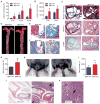The Bcl6-SMRT/NCoR cistrome represses inflammation to attenuate atherosclerosis
- PMID: 22465074
- PMCID: PMC3367511
- DOI: 10.1016/j.cmet.2012.02.012
The Bcl6-SMRT/NCoR cistrome represses inflammation to attenuate atherosclerosis
Abstract
Chronic inflammation is a hallmark of atherosclerosis, but its transcriptional underpinnings are poorly understood. We show that the transcriptional repressor Bcl6 is an anti-inflammatory regulator whose loss in bone marrow of Ldlr(-/-) mice results in severe atherosclerosis and xanthomatous tendonitis, a virtually pathognomonic complication in patients with familial hypercholesterolemia. Disruption of the interaction between Bcl6 and SMRT or NCoR with a peptide inhibitor in vitro recapitulated atherogenic gene changes in mice transplanted with Bcl6-deficient bone marrow, pointing to these cofactors as key mediators of Bcl6 inflammatory suppression. Using ChIP-seq, we reveal the SMRT and NCoR corepressor cistromes, each consisting of over 30,000 binding sites with a nearly 50% overlap. While the complete cistromes identify a diversity of signaling pathways, the Bcl6-bound subcistromes for each corepressor are highly enriched for NF-κB-driven inflammatory and tissue remodeling genes. These results reveal that Bcl6-SMRT/NCoR complexes constrain immune responses and contribute to the prevention of atherosclerosis.
Copyright © 2012 Elsevier Inc. All rights reserved.
Figures



References
-
- Adhikari N, Charles N, Lehmann U, Hall JL. Transcription factor and kinase-mediated signaling in atherosclerosis and vascular injury. Curr Atheroscler Rep. 2006;8:252–260. - PubMed
-
- Basso K, Dalla-Favera R. BCL6: master regulator of the germinal center reaction and key oncogene in B cell lymphomagenesis. Adv Immunol. 105:193–210. - PubMed
Publication types
MeSH terms
Substances
Associated data
- Actions
Grants and funding
- P01 HL088093/HL/NHLBI NIH HHS/United States
- R37DK057978/DK/NIDDK NIH HHS/United States
- R01 HD027183/HD/NICHD NIH HHS/United States
- U19DK062434/DK/NIDDK NIH HHS/United States
- P30 DK063491/DK/NIDDK NIH HHS/United States
- HHMI/Howard Hughes Medical Institute/United States
- P30DK063491/DK/NIDDK NIH HHS/United States
- R37 DK057978/DK/NIDDK NIH HHS/United States
- R01 HL086566/HL/NHLBI NIH HHS/United States
- R01HD027183/HD/NICHD NIH HHS/United States
- R01 CA104348/CA/NCI NIH HHS/United States
- P30 CA014195/CA/NCI NIH HHS/United States
- K08HL092298/HL/NHLBI NIH HHS/United States
- K08 HL092298/HL/NHLBI NIH HHS/United States
- U19 DK062434/DK/NIDDK NIH HHS/United States
- P01HL088093/HL/NHLBI NIH HHS/United States
- CA014195-38/CA/NCI NIH HHS/United States
- R01HL086566/HL/NHLBI NIH HHS/United States
LinkOut - more resources
Full Text Sources
Other Literature Sources
Medical
Molecular Biology Databases

